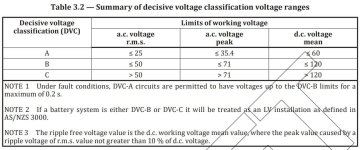Doctorbass
100 GW
About code.
I see many mention that always talk about LESS THAN 50V system (in DC) however very few mention it's a NOMINAL voltage but not all. I think they should at least ALL mention nominal, max voltage, full voltage or charge or peak Voltages
48V in Lead acid is 57.6V full = over 50V
48V in 13s Li-Ion is 54.6Vdc full = over 50V
48V in LiFePO4 16s of 58.4Vdc full = over 50V
48V nominal lead acid is 51.2Vnom = over 50V
48V nominal Li-Ion 13s is 47.45Vdc = OK below 50V
48V nominal LiFePO4 16s = 51.2V = over 50V
Electrical safety is only assured with a proper workplace hazard evaluation, and energized work less than 50 volts (AC or DC) needs to fall in line with the requirements of NFPA 70E 130.2(A)(3).
It seem there is a lack of clarification in these CODES as many actual LiFePO4 commercially available are in 16s configuration which is 51.2V and therefore treated differently. The only combinaison that comply is with 13s Li-Ion of 47.45Vdc which is below 48V and the 50V or less...
I hate when code and standards take time to specify every single details with appendix, list, violation etc.. but just most of the time dont what kind of Dc Voltage is...
It seem that Battery are treated just like the AC of the grid which is stable 120V or 240V but not a variable voltage from a battery when opeationg from various SOC...
What info do you have on your side about that?
I see many mention that always talk about LESS THAN 50V system (in DC) however very few mention it's a NOMINAL voltage but not all. I think they should at least ALL mention nominal, max voltage, full voltage or charge or peak Voltages
48V in Lead acid is 57.6V full = over 50V
48V in 13s Li-Ion is 54.6Vdc full = over 50V
48V in LiFePO4 16s of 58.4Vdc full = over 50V
48V nominal lead acid is 51.2Vnom = over 50V
48V nominal Li-Ion 13s is 47.45Vdc = OK below 50V
48V nominal LiFePO4 16s = 51.2V = over 50V
Electrical safety is only assured with a proper workplace hazard evaluation, and energized work less than 50 volts (AC or DC) needs to fall in line with the requirements of NFPA 70E 130.2(A)(3).
It seem there is a lack of clarification in these CODES as many actual LiFePO4 commercially available are in 16s configuration which is 51.2V and therefore treated differently. The only combinaison that comply is with 13s Li-Ion of 47.45Vdc which is below 48V and the 50V or less...
I hate when code and standards take time to specify every single details with appendix, list, violation etc.. but just most of the time dont what kind of Dc Voltage is...
It seem that Battery are treated just like the AC of the grid which is stable 120V or 240V but not a variable voltage from a battery when opeationg from various SOC...
What info do you have on your side about that?


